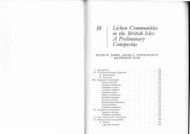Create successful ePaper yourself
Turn your PDF publications into a flip-book with our unique Google optimized e-Paper software.
consists <strong>of</strong> an accumulation <strong>of</strong> tiny, ± spherical<br />
reproductive granules, the soredia. The soredia<br />
usually lie close to the algae layer <strong>of</strong> the thallus.<br />
Position and form <strong>of</strong> the soralia are species<br />
specific distinctions. They may sit upon the<br />
surface, at the edge or on the ends <strong>of</strong> lobes, have<br />
a long streak linear or rounded outline and be<br />
concave to strongly convex or lip-form. The<br />
various types <strong>of</strong> soralia are considered in the list<br />
<strong>of</strong> technical terms. An oversight <strong>of</strong> distinct<br />
forms results in the following illustration. Many<br />
lichen species produce no normal bordered<br />
soralia, but large areas <strong>of</strong> the upper surface<br />
becomes sorediate or even the entire thallus.<br />
Rhizines, Cilia, and Pseudocyphellae<br />
On the underside <strong>of</strong> foliose lichens are found<br />
attachment organs which serve to attach the<br />
thallus to the substrate. The most frequent are<br />
rhizines (fastening filaments); which may be<br />
regarded as simple, forked or like a brush or<br />
bottle cleaner (Illustrated on page 729). In the<br />
case <strong>of</strong> many foliose lichens the underside is<br />
covered with a ± thick hairy layer, in others a<br />
network develops. Soil-dwelling fruticose<br />
lichens sit loosely on the substrate, rock and bark<br />
dwellers are generally attached with a somewhat<br />
broader base, an attachment disk.<br />
In the case <strong>of</strong> some few species <strong>of</strong> foliose and<br />
fruticose lichens the indigenous flora the lobe<br />
margins or lobe ends are provided with<br />
characteristic setiform projections (also known as<br />
cilia) (See page 75). Pseudocyphellae are also<br />
important diagnostic structures. These are very<br />
delicate point or linear whitish eruptions or<br />
lacunae in the cortex above all <strong>of</strong> foliose and<br />
fruticose lichens (See page 75 and 276).<br />
Sometimes the lines are reticulate and sit upon<br />
very weakly raised ridges (See page 663).<br />
3.2.3 Structure <strong>of</strong> the Thallus<br />
In the lichen the fungus envelops with a mesh <strong>of</strong><br />
filamentous structures (hyphae) usually<br />
numerous single, rarely multicellular algae the<br />
partner species. The algae are commonly<br />
concentrated in a zone, in the case <strong>of</strong> gelatinous<br />
lichens mostly distributed over the whole thallus.<br />
The residual space in the lichen is taken up by<br />
the fungus partner, which also by the<br />
arrangement <strong>of</strong> the hyphae <strong>of</strong>ten determines the<br />
form <strong>of</strong> the lichen.<br />
Toward the outside the fungus hyphae <strong>of</strong>ten<br />
produces a thick protective, especially structured<br />
cortex. The algae layer, in which the algae are<br />
entwined by fungus hyphae, lies under the cortex.<br />
Under the algae layer is developed a usually<br />
relatively thick medulla <strong>of</strong> loosely interwoven<br />
hyphae. In the case <strong>of</strong> crustose lichens, the<br />
thallus with the medulla rests upon the substrate.<br />
In the case <strong>of</strong> foliose and fruticose lichens, a<br />
cortex is usually also developed on the<br />
underside, i.e. the lichen is encircled by a<br />
surrounding cortex layer. Special attachment<br />
organs <strong>of</strong>ten also occur on the underside, e.g.<br />
rhizines.<br />
The cortex in section shows a structure <strong>of</strong><br />
more or less rounded-multiangular cells (see<br />
page 24), which are called paraplectenchymous<br />
or pseudoparenchymous (reminiscent <strong>of</strong> a<br />
parenchyma <strong>of</strong> higher plants). If they are more<br />
parallel structured <strong>of</strong> elongated cells, they are<br />
called prosoplectenchymous (see page 24).<br />
Almost all lichen fungi belong to the<br />
ascomycetes, to which e.g. also are numbered the<br />
cup-fungi and morels. Yet the lichen fungi do<br />
not <strong>of</strong>ten occur free-living, but have become<br />
completely dependent upon the lichen symbiosis.<br />
The lichen algae belong for the most part to the<br />
green algae, to a smaller degree to the blue-green<br />
algae or cyanobacteria. Each lichen species is<br />
characterized by a specific fungus, occurring<br />
only in it, as well as by a mostly definite species<br />
<strong>of</strong> algae. One and the same alga species may<br />
occur in various lichen species. For an oversight<br />
<strong>of</strong> the most frequent algae see page 64 and<br />
illustrations on page 64 and 65.<br />
3.2.4 Form and Structure <strong>of</strong> the Fruiting<br />
Body<br />
General<br />
Fruiting bodies are relatively frequent in the case<br />
<strong>of</strong> crustose lichens. Many native foliose and<br />
fruticose lichens on the other hand do not<br />
commonly fruit and reproduce instead<br />
vegetatively with the help <strong>of</strong> soredia, isidia,<br />
thallus fragments. Conversely, as a rule,<br />
regularly fruiting species do not produce<br />
vegetative reproductive organs.<br />
Fruiting bodies appearing in lichens result in<br />
connection with sexual process <strong>of</strong> the lichen<br />
fungus. Since almost all lichen fungi belong to<br />
the Ascomycetes, the fruiting bodies are the so<br />
called ascocarps. When the spore generating<br />
tissue (hymenium) lies open to view, it is an<br />
apothecium, if it is enclosed in a more or less<br />
spherical structure and only open to the world<br />
10





